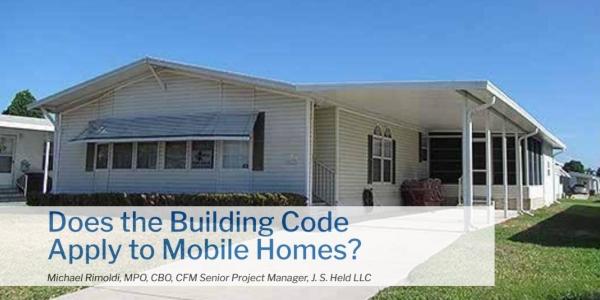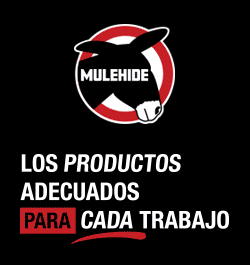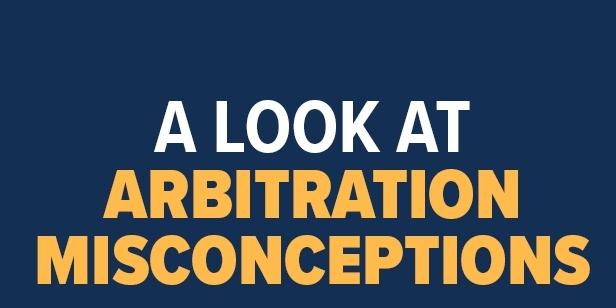Do Mobile Homes Have to Comply With Building Codes?

By Michael Rimoldi for Florida Roofing and Sheet Metal Contractors Association (FRSA).
Clarifying the grey area of jurisdiction when it comes to mobile homes.
There are plenty of people who call the mobile home “home.” However, the semi-permanent and transportable nature of these structures can complicate what “home” means in jurisdiction, for example the Building Code. It seems like a given that buildings are governed by the Building Code, but this isn’t the case. In Florida, the law exempts “structures specifically regulated and preempted by the federal government” from the requirements of the Florida Building Code (FBC). So does the FBC require mobile homes to comply? Yes and no.
To better understand where we are today regarding this issue, we need to understand where we came from. This issue goes back to the “New Deal” passed during the Great Depression, which enacted the “National Housing Act of 1934” in an attempt to protect homeowners from foreclosure. This law was amended in 1937 and again in 1949, which led to the development of several national public housing programs. In 1965, these programs merged into one department, creating the United States Department of Housing and Urban Development (HUD). The law was further amended to become The National Manufactured Housing Construction and Safety Standards Act of 1974 which limited the regulation that local governments had over manufactured structures and recommended that the standards developed by HUD be applied to mobile homes. Several laws have been adopted since that time that have further narrowed the ability of local jurisdictions to regulate mobile structures. Due to the lack of local control, the permitting, construction, inspection, maintenance, repair, etc. of these structures has become a game of finger pointing. However, if we follow the breadcrumbs left for us, we can navigate the various documents governing the use of manufactured homes.
Florida Statute Regulations
At inception, the laws in place regulate the overall idea or intent of the “mobile home.” Florida Statute Chapter 553 provides Building Construction Standards which govern both Manufactured Buildings (F.S. §§ 553.35-553.42) as well as the Florida Building Code (F.S. §§ 553.70-553.898). Upon first glance, F.S. § 553.35 (The Florida Manufactured Building Act of 1979) appears to point us right back to the building code in section 553.355:
Minimum construction requirements established. —The Florida Building Code and the Florida Fire Prevention and Life Safety Codes shall be the minimum construction requirements governing the manufacture, design, construction, erection, alteration, modification, repair and demolition of manufactured buildings.
However, the subsequent section parses out “Mobile Homes” from the globally defined “Manufactured Buildings,” “Modular Building,” or “Factory Built Building” and specifically includes that “this part does not apply to mobile homes.” Mobile homes are specifically defined as “any residential unit constructed to standards promulgated by the United States Department of Housing and Urban Development.” F.S. § 553 goes on to provide specific requirements for “manufactured buildings” but, as previously noted, this part does not apply to “mobile homes.” Further into the statutes, the vague definition of “mobile home” is refined in Chapter 723 Mobile Home Park Tenancies – Section 723.003 Definitions:
(8) “Mobile home” means a residential structure, transportable in one or more sections, which is 8 body feet or more in width, over 35 body feet in length with the hitch, built on an integral chassis, designed to be used as a dwelling when connected to the required utilities, and not originally sold as a recreational vehicle, and includes the plumbing, heating, air-conditioning, and electrical systems contained therein.
Although this definition applies specifically to Chapter 723, this aids in our understanding of what a “mobile home” truly is. For standard mobile homes, the topic of this discussion, we can now proceed to the standards developed and regulated by HUD.
HUD Regulations
The HUD documents, which regulate the construction and transport of mobile homes, are found in the Code of Federal Regulations Title 24, Housing and Urban Development Subtitle B, most notably Part 3280 and Part 3285. The former provides “Manufactured Home Construction and Safety Standards” while the latter provides “Manufactured Home Installation Standards.” In short, these documents provide the regulations applicable from the beginning of the manufacturing process, to the preparation for transport and then for the delivery to a specific site and on until the installation has been completed, at which time the structure is able to be occupied and used as a dwelling unit.
However, between the manufacturing of the structure and installation of the structure, there exists a very important phase: transportation. Given that these structures are mobile homes, the Department of Highway Safety and Motor Vehicles (DMV) also has jurisdiction over their construction and transport, thus requiring them to be registered with the DMV. All mobile homes placed on leased property are required to be registered each year. However, if placed on a property that is owned, the home may qualify to be taxed as real property and a permanent, one-time registration sticker can be purchased. We can find additional requirements within Florida Statute Chapter 320, Motor Vehicle Licenses.
Section 320.822 provides definitions applicable to this section: 320.822(2) “Code” means the appropriate standards found in:
(a) The Federal Manufactured Housing Construction and Safety Standards for single-family mobile homes, promulgated by the Department of Housing and Urban Development
(b) The Uniform Standards Code approved by the American National Standards Institute, ANSI A-119.2 for recreational vehicles and ANSI A-119.5 for park trailers or the United States Department of Housing and Urban Development standard for park trailers certified as meeting that standard
(c) The Mobile Home Repair and Remodeling Code and Used Recreational Vehicle Code.
320.8232 Establishment of uniform standards for used recreational vehicles and repair and remodeling code for mobile homes:
(1) Each used recreational vehicle manufactured after January 1, 1968 and sold or offered for sale in this state by a dealer or manufacturer shall meet the standards of the Used Recreational Vehicle Code. The provisions of said code shall ensure safe and livable housing and shall not be more stringent than those standards required to be met in the manufacture of recreational vehicles. Such provisions shall include, but not be limited to, standards for structural adequacy, plumbing, heating, electrical systems and fire and life safety.
(2) The provisions of the repair and remodeling code shall ensure safe and livable housing and shall not be more stringent than those standards required to be met in the manufacture of mobile homes. Such provisions shall include, but not be limited to, standards for structural adequacy, plumbing, heating, electrical systems and fire and life safety.
In short, Section 320.8232 requires that standards for the repair and remodeling of mobile homes be established. This requirement points us to F.S. § 320.822(2)(c) (previous page), which referenced “The Mobile Home Repair and Remodeling Code and Used Recreational Vehicle Code.” It should be noted that the statute limits the regulations on the repairs or remodels of mobile homes to be no more stringent than was required for the manufacture of the structure. Section 320.8245 goes on to provide limitations of alteration or modification to mobile homes or recreational vehicles.
Department of highway safety and motor vehicles regulations
Florida Administrative Code provides the Rules of Department of Highway Safety and Motor Vehicles Division of Motor Vehicles Chapters 15C-1 and 15C-2. Chapter 15C-1 provides General Rules regarding the installation of mobile homes and generally refers back to the manufacturer’s installation instructions or the HUD standards. However, some prescriptive installation standards are provided. As noted above, one of the codes governing mobile homes is the “The Mobile Home Repair and Remodeling Code and Used Recreational Vehicle Code.” The Mobile Home Repair and Remodeling Code is also known as 15-C-2.0081. Although quite brief, this code reiterates the requirements set forth in F.S. § 320.822. In its entirety, the code is as follows:
15C-2.0081 Mobile/Manufactured Home Repair and Remodeling Code.
These guidelines shall be used to assure safe and livable housing and shall not be more stringent than the standard to which the home was originally constructed.
(1) Structure.
(a) Additions, including, but not limited to adda-rooms, roof-overs and porches shall be free standing and self-supporting with only the flashing attached to the main unit unless the added unit has been designed to be married to the existing unit. All additions shall be constructed in compliance with State and locally adopted building codes.
(b) Anchoring of additions shall be in compliance with requirements for similar type construction.
(c) Repair or remodeling of a mobile/manufactured home shall require the use of material and design equivalent to the original construction. Structure shall include, but not be limited to, roof system, walls, floor system, windows and exterior doors of the mobile/manufactured home.
(2) Electrical repair and replacements shall require the use of material and design equivalent to the original construction.
(3) Plumbing repairs and replacements shall require the use of material and design equivalent to the original construction.
Florida Building Code regulations
So, at this point we have the Florida Statutes, the Code of Federal Regulations, HUD, Florida Administrative Code and the DMV sharing in the governing of the manufacturing and use of mobile homes. But where did the FBC go? The Florida Building Code, Building was noted earlier to have departed from the jurisdiction over mobile homes. However, the Florida Building Code, Residential discusses “mobile homes” in a few sections. The Residential code defines the term “manufactured home” as follows:
Manufactured home
Manufactured home means a structure, transportable in one or more sections, which in the traveling mode is 8 body feet (2,438 body mm) or more in width or 40 body feet (12,192 body mm) or more in length, or, when erected on site, is 320 square feet (30 m2) or more, and which is built on a permanent chassis and designed to be used as a dwelling with or without a permanent foundation when connected to the required utilities, and includes the plumbing, heating, air-conditioning and electrical systems contained therein; except that such term shall include any structure that meets all the requirements of this paragraph except the size requirements and with respect to which the manufacturer voluntarily files a certification required by the secretary (HUD) and complies with the standards established under this title. For mobile homes built prior to June 15, 1976, a label certifying compliance to the Standard for Mobile Homes, NFPA 501, in effect at the time of manufacture is required. For the purpose of these provisions, a mobile home shall be considered a manufactured home.
This definition is quite similar to the definition included in F.S. § 723.003. This brings us to one of the few conditions for which the FBC does have jurisdiction over mobile homes. Chapter 3 of the Residential code provides the following provision:
R322.1.9 Manufactured homes. In addition to the applicable requirements of the state agency with jurisdiction over installation of manufactured homes, installation of manufactured homes in flood hazard areas is subject to the applicable provisions of the local floodplain management ordinance.
Mobile home identification
Mobile homes are required to have identifiers which provide pertinent information regarding the construction of the structure. This differs from manufactured buildings which aren’t governed by HUD. All mobile homes are required to have a Data Plate. The data plate should be in a readily accessible location and permanently fixed. Typically, the data plate is attached to or inside of the main electrical panel. The data plate provides at a minimum:
(a) The name and address of the manufacturing plant in which the manufactured home was manufactured.
(b) The serial number and model designation of the unit and the date the unit was manufactured.
(c) The applicable statement: This manufactured home is designed to comply with the Federal Manufactured Home Mobile homes in flood hazard area Mobile homes in flood hazard area. Construction and Safety Standards in force at the time of manufacture; or this manufactured home has been substantially completed in accordance with an approved design and has been inspected (except for the components specifically identified in the instructions for completion on-site) in accordance with the Federal Manufactured Home Construction and Safety Standards and the requirements of the Department of Housing and Urban Development (HUD) in effect on the date of manufacture.
(d) A list of the certification label(s) number(s) that are affixed to each transportable manufactured section under §3280.8.
(e) A list of major factory-installed equipment, including the manufacturer’s name and the model designation of each appliance.
(f) Reference to the roof load zone and wind load zone for which the home is designed and duplicates of the maps as set forth in §3280.305(c). This information may be combined with the heating/cooling certificate and insulation zone map required by §§3280.510 and 3280.511. The Wind Zone Map on the Data Plate shall also contain the statement: This home has not been designed for the higher wind pressures and anchoring provisions required for ocean/coastal areas and should not be located within 1500’ of the coastline in Wind Zones II and III, unless the home and its anchoring and foundation system have been designed for the increased requirements specified for Exposure D in ANSI/ASCE 7-88.
(g) The statement: This home has—has not— (appropriate blank to be checked by manufacturer) been equipped with storm shutters or other protective coverings for windows and exterior door openings. For homes designed to be located in Wind Zones II and III, which have not been provided with shutters or equivalent covering devices, it is strongly recommended that the home be made ready to be equipped with these devices in accordance with the method recommended in the manufacturer’s printed instructions.
(h) The statement: “Design Approval by,” followed by the name of the agency that approved the design. As noted in item (d) above, each transportable section shall have a permanently affixed certification label (shown above). The certification label is to be located at the taillight end of the section near the base of the vinyl siding and is blind rivetted to the siding. The label is required to be approximately 2”x4” in size and should be etched into 0.32-inch-thick aluminum plate. The certification label, often referred to as the “construction code label,” is one of the easiest ways to recognize a mobile home and differentiate one from a manufactured building.
Conclusion
In summary, the manufacturing of mobile homes is governed by HUD as defined in the Florida Statutes. However, because these structures must be transported, they must also comply with the requirements for mobile vehicles which are governed by the DMV. Once a mobile home arrives on site, it must be installed according to the HUD standards. However, the mobile home must comply with the floodplain requirements of the FBC, Residential and the local floodplain ordinance. Additionally, any appurtenant structures built on site are required to comply with the FBC.
It should be noted that appurtenant structures must be self-supported because modifications to and alterations of mobile homes are restricted within the Florida Statutes. Furthermore, repairs to damaged components are governed by the requirements of the Florida Administrative Code, as found within the rules of the DMV. The local Authority Having Jurisdiction (AHJ) is the responsible entity for the enforcement of some of the regulations mentioned in this document hence the reason you will see permits issued for the placement, tie down and floodplain related aspects of manufactured homes.
Learn more about FRSA in their RoofersCoffeeShop® Directory or visit www.floridaroof.com
Original article source: FRSA






















Comments
Leave a Reply
Have an account? Login to leave a comment!
Sign In